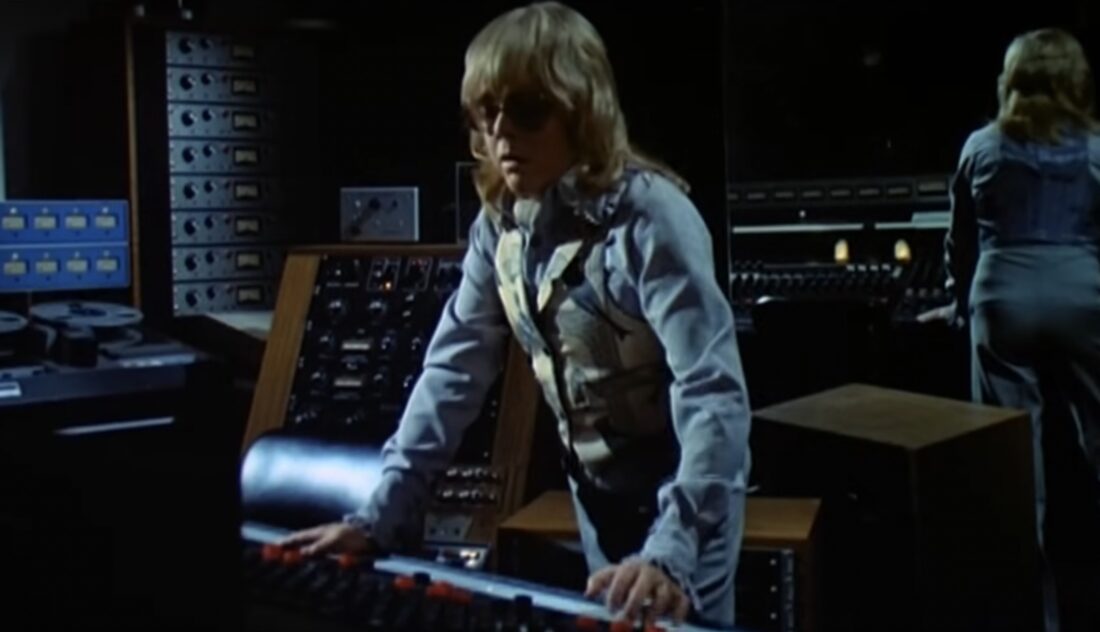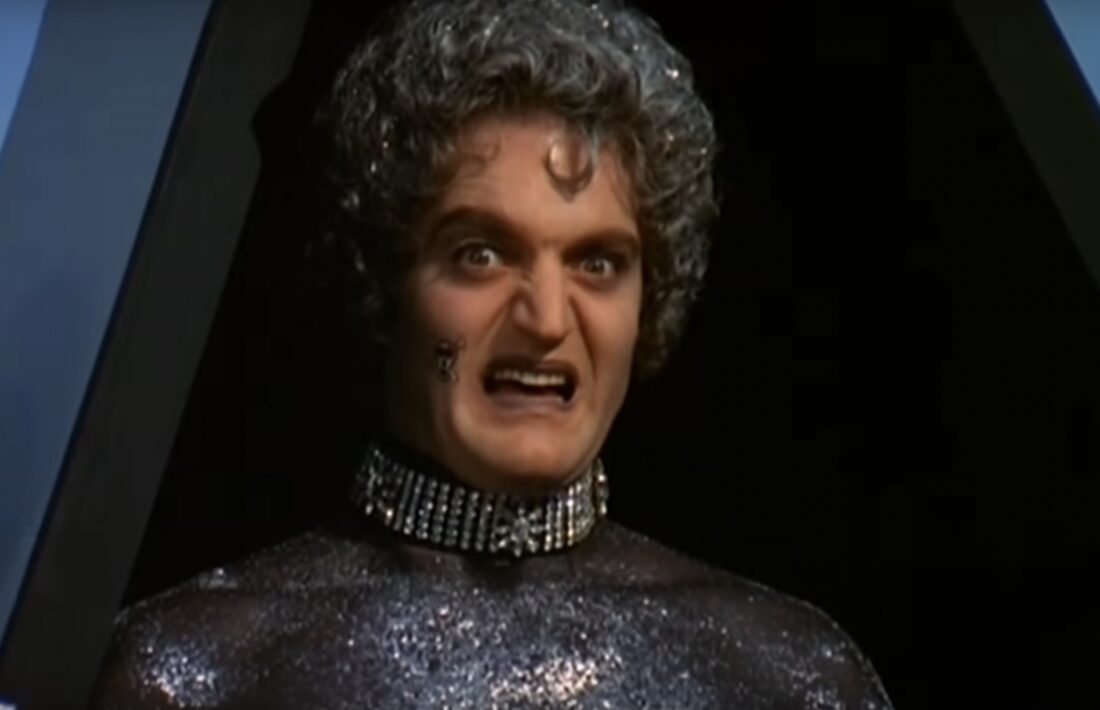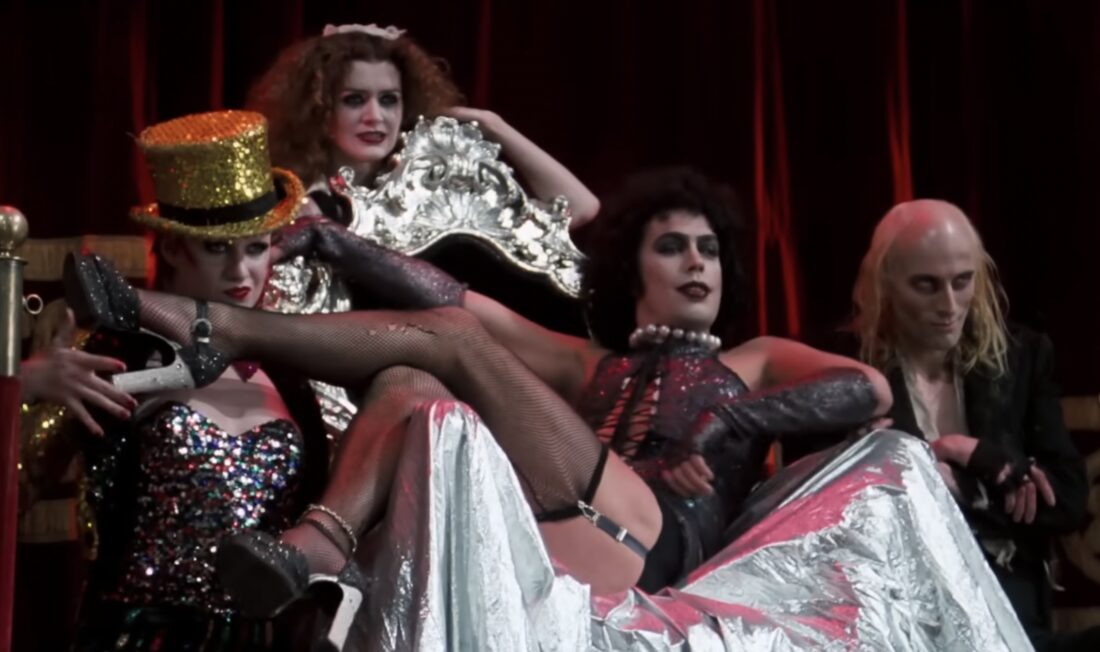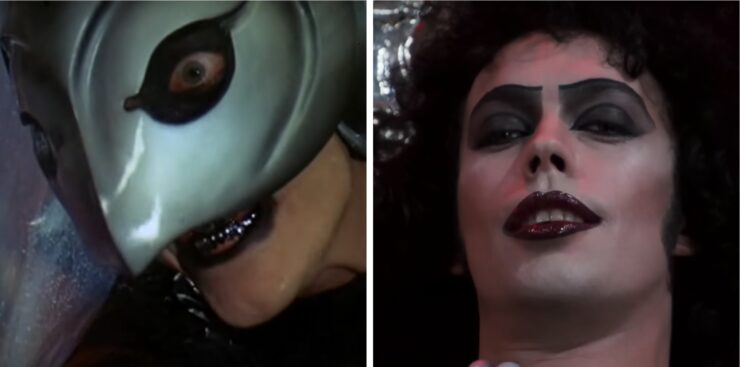Rock musicals, either based on existing material (recordings and stage shows) or wholly original, were a thing at the movies in the 1970s: think Tommy, Hair, or Jesus Christ Superstar. But incredibly, within that specific genre, there appeared within a year of each other two films that found themselves in an even more granular niche: rock musical films that satirized both horror movies and certain aspects of ‘70s culture. Both were deemed flops when they first arrived in theaters; one went on to become a modest cult hit with a dedicated following, while the other became an enormous pop culture sensation and, indeed, a global phenomenon that still finds new audiences to this day.
Brian De Palma’s Phantom of the Paradise was released on October 31, 1974, while Jim Sharman’s The Rocky Horror Picture Show premiered a little under a year later, in September 1975. The former was an original, diegetic rock musical developed by De Palma, with songs written by Paul Williams, that paid homage to tales like The Phantom of the Opera and Faust while also spoofing the crass tendencies of the music business and instant fame. It starred Williams as Swan, the literally demonic head of a massive record company, who steals the music of a naïve composer named Winslow Leach (William Finley) and uses it to open his new rock palace, the Paradise. Disfigured and driven insane by Swan’s machinations, Winslow becomes “the Phantom” and begins wreaking havoc on Swan’s plans.
Rocky Horror, meanwhile, began life as a stage show at an experimental theater in London, quickly becoming a massive hit both there and in Los Angeles, which led to the show being adapted as a film. Both the stage show and the screen version paid homage to the horror and sci-fi movies of the 1930s, ‘40s, and ‘50s, filtered through the sounds of rock music (both ‘50s and glam) and commenting on the changes wrought by both the sexual revolution and the gay liberation movement. It starred a then-unknown Barry Bostwick and Susan Sarandon as Brad and Janet, two virginal squares from the wholesome town of Denton who become trapped one rainy night in the castle of Dr. Frank-N-Furter (Tim Curry), a mad scientist and self-proclaimed “sweet transvestite” who’s in the midst of creating his perfect man but takes time out to introduce his unspoiled guests to the pleasures of the flesh.

De Palma began working on Phantom as early as 1969, with the first drafts of the script completed around 1971. With just a handful of independent features under his belt, the young filmmaker was still years away from the mainstream success of films like Carrie, The Fury, and Dressed to Kill. Rocky Horror, meanwhile, was written around 1972-73 in London by Richard O’Brien, who composed all the music and penned the book and lyrics, while also playing the hunchbacked handyman Riff Raff in the original production and eventually the film. Phantom was independently financed for a little over $1 million and filmed in late ’73 and early ’74, while Rocky Horror (which also cost around $1 million to make) was shot in late 1974, directly after the show had successfully premiered in Los Angeles.
That both films were released within a year of each other seemed more like a happy accident than anything else, and what’s even odder is that both were distributed through 20th Century Fox. But when Phantom came out, it was met with more or less a resounding thud at the box office: beset by bigger releases like Airport 1975, Benji, and The Texas Chain Saw Massacre (the latter two both filmed in Texas, where most of Phantom was also shot), Phantom did not, according to best estimates, even make back its budget, with the film earning around $1,000,000 in its initial release.
One thing that stood out, however, was the film’s run in Winnipeg, Canada. Phantom ran for 62 weeks (four months continuously) there after opening in December 1974, spawning not just a dedicated local following but continued revivals over the years and even a mini-convention of fans called “Phantompalooza.” Although the movie was overall deemed a failure at the time, it was perhaps those fleeting signs of life up north that inspired 20th Century Fox to make changes to the way it distributed and marketed The Rocky Horror Picture Show the following year.
Indeed, Rocky Horror at first seemed destined for the same obscure fate as Phantom: aside from a strong showing at one Los Angeles theater, its initial limited release in a handful of cities was met with empty auditoriums (it didn’t help that the show had bombed on Broadway a few months earlier, closing after just three weeks at the Belasco Theatre). Even a double-bill with, of all things, Phantom of the Paradise didn’t seem to stoke audience interest. It wasn’t until a Fox marketing exec named Tim Deegan convinced Manhattan’s Waverly Theater in spring 1976 to start running Rocky Horror at midnight on Fridays and Saturdays that the destiny of the film changed.
Perhaps Deegan had seen the audiences returning to watch Phantom of the Paradise over and over in Winnipeg or had a hunch that Rocky, with its message of sexual liberation (more on that later) would work in the friendlier confines of New York’s Greenwich Village. There was also the previous history of midnight movies, which had been around for a couple of decades already but began gaining real prominence in the late 1960s. Sure enough, a group of devoted fans began returning to the Waverly every weekend, and as the film continued to play, they began to interact with it—everything from shouting back responses to the dialogue in the film to hurling props into the air (like throwing rice for the opening wedding scene) to acting out the film in costume on the floor in front of the screen.
The Rocky Horror phenomenon spread from there, with the film expanding its reach—always at midnight on weekends—to other parts of New York City, then beyond that to the rest of the country. And somehow, in those pre-internet days, the word spread as well: dress up, bring props, shout back lines (almost always the same lines) at the screen, and dance the Time Warp to your heart’s content. To this day—even though it’s been made widely available in the years since on home video and can be even be seen on the Disney+ streaming service as I write this—The Rocky Horror Picture Show still plays in theaters around the country at midnight on weekends, making it the biggest cult movie of all time—the queen of cult movies, if you will—and the longest continuously running motion picture in history.
Meanwhile, Phantom of the Paradise languished in near-cinematic oblivion, seemingly all but forgotten even as Brian De Palma went on to direct mainstream Hollywood hits like Scarface, The Untouchables, and Mission: Impossible. Phantom has been reappraised and rediscovered over the years, with fans and critics calling it one of De Palma’s best films and a number of film journalists noting the parallels with Rocky Horror and declaring it the better film. So why did Rocky become a pop culture institution while Phantom remained relegated to the traditional definition of a cult movie?

A conventional wide release was never going to work for either of these two genuinely offbeat movies. Perhaps 20th Century Fox did learn something from seeing how Phantom tanked in wide release, pulling Rocky Horror from theaters quickly enough to remove the stigma of failure from it. But while the studio didn’t act on the prospect of Phantom becoming something that a niche audience would discover and embrace on its own—save for that one lonely outpost in Winnipeg—Fox did take that lesson to heart and apply it to Rocky Horror.
Even if Phantom had been granted the same “midnight movie” re-release as Rocky Horror, however, there are several reasons why the film may not have taken off in the same way. Viewing the films back-to-back, it’s clear (at least to this writer) that Phantom is the better movie. It’s got a stronger script, better-realized characters, largely better acting, and De Palma was already skilled (this was his eighth film) at staging, editing, and composition, utilizing a bag of tricks that included everything from split-screen to little Hitchcock homages. Phantom, in that sense, is a truly cinematic experience.
Rocky, on the other hand, was only director Jim Sharman’s second feature film (he was more of a theater director) and while he gets the horror backdrops that Rocky spoofs right, as well as the stylized costumes and performances, the filmmaking itself is nothing exceptional and frequently static. The energy tends to drop between the musical numbers, and even the best numbers are front-loaded in the first half of the film. What Rocky does have is the majestic presence of Tim Curry as Frank-N-Furter, who drives the film in a way that no one else in either movie does. Rocky also has a campier, looser, “zanier” feel to it, thanks to its origins as a revue-style stage show. As a result, Rocky may lend itself more effectively to the audience participation that fueled the movie’s success.
The songs in Phantom, as we noted earlier, are diegetic: they are sung by the performers within the context of the narrative, as part of a production the characters are creating. As such, they don’t advance the story or characters in any way, although they do indirectly comment on the action on screen. Rocky Horror, on the other hand, follows a more traditional musical route: the characters aren’t “aware” that they’re singing, and the musical numbers do push the story, the characters, and their motivations (thin as they are) forward. And while the songs in Phantom are great, they’re also largely moody in nature; even the movie’s opening number, the ‘50s-styled “Goodbye, Eddie, Goodbye,” is about suicide. Rocky’s best songs are celebratory, anthemic, and upbeat, like “Science Fiction/Double Feature,” “Sweet Transvestite,” “Wild and Untamed Thing,” “Whatever Happened to Saturday Night?” and, of course, “The Time Warp”—again, making them more accessible to live participation.
The horror and sci-fi references in Rocky Horror, subverted as they are, are also perhaps more recognizable to movie audiences, based on such archetypes as the mad scientist, the Frankenstein creation story, the hunchbacked assistant, the innocents trapped in the sinister old castle, and toward the end, the old alien invader trope complete with death rays and teleportation devices. It’s all silly (in a good way) and doesn’t make a lot of conventional sense, but it adds to the fun, B-movie, campier vibe that Rocky Horror does effectively deploy.
Phantom, on the other hand, has a more literary pedigree: while The Phantom of the Opera, certainly an iconic horror property, is the main influence, De Palma also draws on works of literature like Faust and The Picture of Dorian Gray—not exactly obscure, but not as instantly familiar. Phantom also takes direct aim at a “real world” institution—the music business, where Swan and his minions are seen as so corrupt, so venal, and so superficial that Swan not only makes a literal deal with the devil for his success, but is so repulsed at the idea of sharing that success with his new singing sensation, Phoenix (Jessica Harper), that he plans to have her killed on live television: “That’s entertainment,” he cackles, in one of the film’s digs at both the industry’s greed and its tendency to chew its artists up and spit them out.
This makes Phantom the darker of the two films, and sharper-edged in its satire. While Phantom does have its comedic and camp aspects, it doesn’t open itself up to a participatory audience in the same way that Rocky Horror does (although both movies end on a down note, with most of the main cast members dead or permanently damaged in some way by their experiences).

The final, and perhaps most important, element of why Rocky Horror succeeded while Phantom didn’t has to do with the films’ sexual politics and the era’s social climate. The former in Phantom are either stereotypical or transactional: Phoenix, initially portrayed as relatively virtuous, is ready to sleep with Swan as soon as he dangles success in front of her. Swan himself is predatory and homophobic. And then there’s Beef (Gerrit Graham), the superficially aggressive and hetero glam rock singer who turns out to be a lisping, preening caricature offstage. Beef is supposed to be part of the film’s comic relief (and has a showstopper of a death scene), but he’d hardly pass muster today.
Rocky Horror, in the light of modern day, has its issues too: while Frank is portrayed as gender-fluid (he’s not a transgender person, although he can be played that way) and the primary celebrant of the film’s main theme—“don’t dream it, be it”—he’s still very much the murderously petty villain of the piece. He also more or less forces himself on both Brad and Janet, pretending to be one to the other and vice versa, and their consent is half-hearted at best.
Yet there’s no question that despite these problems, Rocky Horror does celebrate sexual freedom—the white hetero virgins Janet and Brad are the ones audiences boo most frequently, until they finally embrace their own untapped sexuality—and the film remains a cornerstone for the LGBTQ+ community. In the 1970s, with the ramifications of the Stonewall uprising still being felt and the sexual revolution in broad terms underway, weekly screenings of The Rocky Horror Picture Show became an enduring safe space for members of the non-hetero community to find and celebrate each other and the film’s (mostly) sex-positive message.
The live floor show by members of the audience, the skimpy, colorful costumes, the boisterous back-and-forth with the dialogue on screen—all were part of queer culture’s own relationship with art and expression. One study published by Wayne State University on the connection between the film and the queer community likened the midnight showings of Rocky Horror to “their own weekly pride parade” and “a ritualistic gathering of the ones you love.”
That last element of the Rocky Horror sensation is one that Phantom of the Paradise could never hope to have. Rocky Horror tapped directly into powerful new currents in the sexual climate of the time that Phantom didn’t even address—that’s not a knock on the latter movie, but simply an acknowledgement that Rocky found a devoted audience to whom it spoke in ways that very few pop culture artifacts were doing at the time.So yes, in terms of cinema, we still think that Phantom of the Paradise is the superior film. But its strangeness and weird fusion of genres proved unmarketable in a conventional sense, making it the guinea pig from which 20th Century Fox gleaned some important insight into cult movies. That insight, combined with an appeal and marketing that was simultaneously broader and more targeted than that of Phantom, made The Rocky Horror Picture Show into the unconventional classic it is today. Yet both films exist in conversation with each other, and I’m glad that we have both to enjoy to this day.










